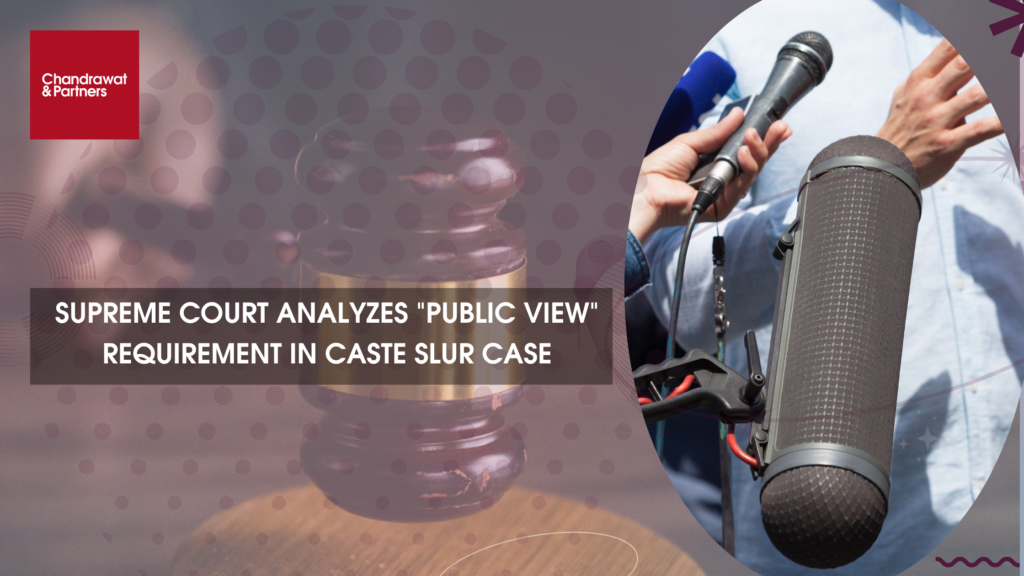
Share :
THE CASE
In a recent landmark judgment, the Supreme Court of India provided much-needed clarity on the interpretation and application of Section 3(1)(r) of the Scheduled Castes and Scheduled Tribes (Prevention of Atrocities) Act, 1989. The case of Priti Agarwalla and Others v. The State of GNCT of Delhi and Others (Criminal Appeal No(s). 348 of 2021) has far-reaching implications for the legal framework surrounding caste-based insults and humiliation.
In a significant decision, the Supreme Court of India examined the outlines of what constitutes an offense of intentional insult or intimidation to humiliate a member of a Scheduled Caste or Scheduled Tribe “in any place within public view” under Section 3(1)(r) of the Scheduled Castes and Scheduled Tribes (Prevention of Atrocities) Act.
FACTUAL BACKGROUND
The case arose from a dispute between two trainee athletes at the Olympic Riding and Equestrian Academy in New Delhi. Respondent No. 2 filed a complaint alleging that the appellants, who were fellow trainees, had hurled casteist slurs and insults at them. The complainant sought registration of an FIR under the Scheduled Castes and Scheduled Tribes (Prevention of Atrocities) Act, 1989.
Initially, the Metropolitan Magistrate ordered a preliminary inquiry into the complaint. However, the High Court allowed the complaint and directed registration of an FIR, for which the appellants then challenged in the Supreme Court.
THE SUPREME COURT’S OBSERVATIONS
At the outset, the Supreme Court bench comprising Justices MM Sundresh and SVN Bhatti emphasized that if allegations in a petition are vague and do not disclose the ingredients of an offense, registration of an FIR and investigation cannot be ordered.
The Court then delved into the crux of the matter – the interpretation of Section 3(1)(r) of the Act, which criminalizes “intentional insult or intimidation intended to humiliate a member of a Scheduled Caste or a Scheduled Tribe in any place within public view.”
The Court underscored the significance of the phrase “in any place within public view” and clarified that ‘public view’ means within the view of a person other than the complainant.
ANALYZING THE ALLEGATIONS
Upon examining the allegations against the appellants, the Court found them to be ambiguous and lacking specificity regarding the place and public view where the alleged insults were made.
The Court highlighted that while Appellant No. 2 was accused of using casteist slurs, the allegation did not mention the place or public view before whom it was made. Similarly, the allegation against Appellant No. 4 lacked clarity on the year in which the alleged humiliating remark was made, leaving it open to interpretation whether it occurred in 2016 or 2017.
Furthermore, the Court noted that the accusations against Appellant No. 3 and Appellant No. 6 did not refer to casteist slurs but rather general abuses hurled at Respondent No. 2.
THE COURT’S VERDICT
Based on these observations, the Supreme Court concluded that the allegations did not satisfy the requirement of having been made “in any place within public view” as mandated by Section 3(1)(r) of the Act.
While the Court upheld the Metropolitan Magistrate’s order for a preliminary inquiry, it found the High Court’s direction to register an FIR to be unsustainable. The Court cited precedents emphasizing that under Section 156(3) of the Code of Criminal Procedure, the Magistrate must exercise discretion judiciously and apply their mind to the circumstances and the offense alleged against the accused.
THE BROADER IMPLICATIONS
This judgment by the Supreme Court provides crucial guidance on the interpretation and application of Section 3(1)(r) of the Scheduled Castes and Scheduled Tribes (Prevention of Atrocities) Act, 1989. It underscores the importance of specificity in allegations and the requirement of establishing that the alleged insults or humiliation occurred “in any place within public view.”
The Court’s emphasis on the “public view” element aims to strike a balance between protecting the dignity of marginalized communities and preventing misuse of the law based on vague or unsubstantiated allegations.
Furthermore, the Court’s observation regarding the parties’ ability to “calm and guide a horse” highlights the need for introspection and self-discipline, especially in fields that demand composure and focus.
OVERVIEW
The Supreme Court’s judgment in Priti Agarwalla and Others v. The State of NCT of Delhi and Others provides a nuanced interpretation of the law, ensuring that the provisions of the Scheduled Castes and Scheduled Tribes (Prevention of Atrocities) Act are applied judiciously while upholding the principles of justice and fairness.
For more information or queries, please email us at
enquiries@chandrawatpartners.com



